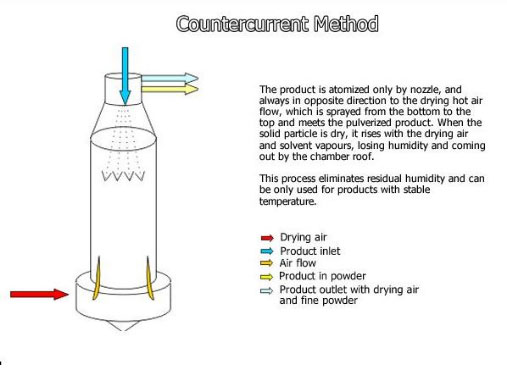ATOMIZATION DRYING
The atomization drying process consists of spraying the product inside the chamber submitting it to a controlled hot draft, generating the solvent evaporation, water in general, obtaining the ultra-fast separation of the existing solids and soluble causing low product degradation by drying, concluding the process with the product recovery transformed into powder.
The equipment exposes the solvent to a temperature gradient control for a few seconds so that it evaporates instantly with a minimum temperature elevation of the material dried in the process.
The control and fine adjustment of the equipment parameters allow the flexibility of its use, turning the atomization drying process one of the most versatile and flexible systems in the drying market, making possible the acquisition of a product of excellent quality.
There is a wide range of products that requires the use of the atomization drying system, that maintains the physicochemical properties of the products and in some cases improves those properties. Through a solution, emulsion, suspension or paste, the diversity of products that can be dried by this system is enormous both in the Chemical and Food industries. Milk Powder, juices, instant soups, detergents are a few examples of products.
The Atomization Drying process is also used to preserve food. In this simple and ultra-fast process, solids and soluble solids can be dried with the highest quality and preserving the essential characteristics. This process also offers advantages in weight and volume reduction.
The process is known for spraying the fluid or its mixture inside a chamber submitted to a controlled hot draft. This fluid is atomized in millions of individual micro-drops by a rotary disk or pulverizer. Through this process the surface area of the powdered product is vastly increased, and inside the chamber along with the hot draft it produces a fast solvent vaporization, water in general, causing frigoria in the center of each micro-drop where there is solid. It dries smoothly without thermal shock, turning the procuct into powder. The process is concluded when the product is collected.
Comments:
- The indirect oven is indicated so that the combustion gases don't get in touch with the product, condition practically obligatory when it is an export product.
- The auxiliary atomizer keeps the machine working when there is the need for maintenance of this part in particular.
- Gas washer: where the legislation doesn't allow any pollution, the washer keeps the fine solids that would eventually pass through the chimney, only releasing water steams and combustion gases.

Follow the links below what was exposed.
Steam Graph
Combined Method Type Fount
Co-Current Method
Technical specifications table

 Portuguese
Portuguese Inglês
Inglês Espanhol
Espanhol







